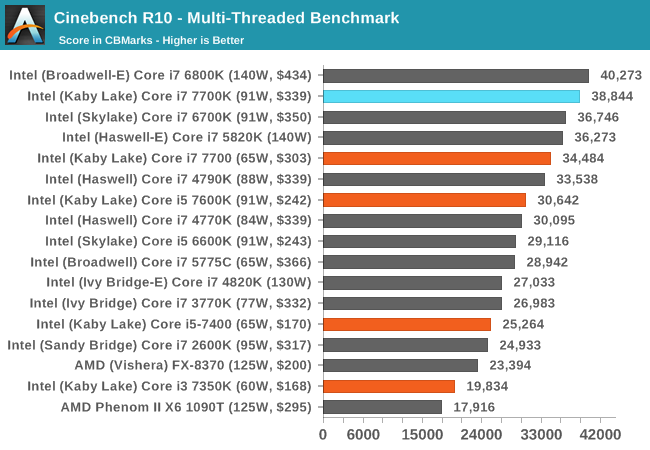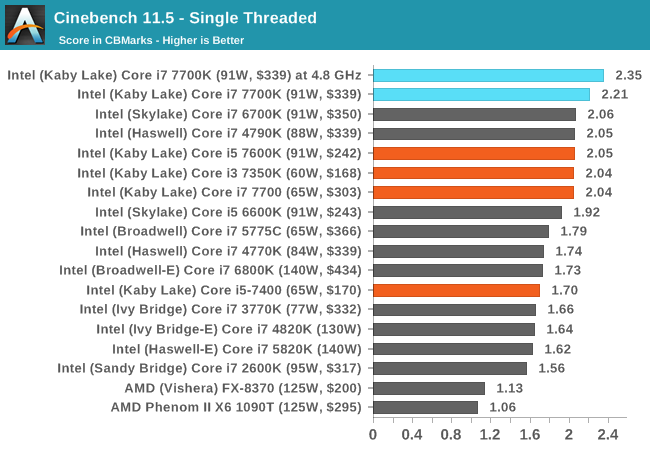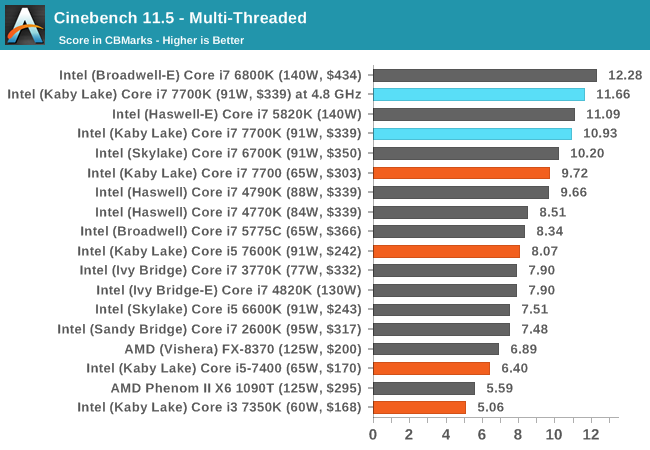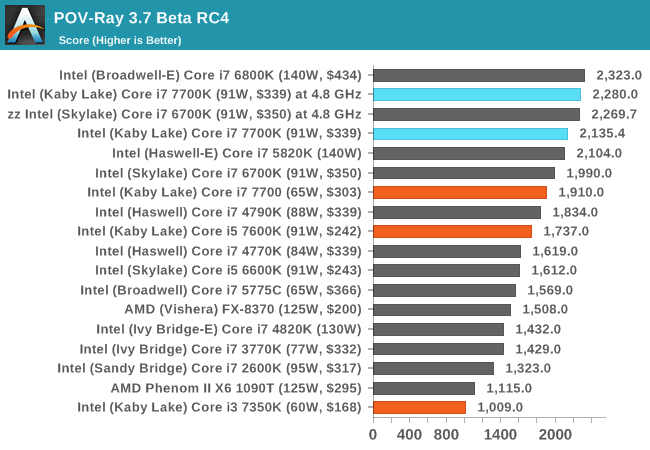The Intel Core i7-7700K (91W) Review: The New Out-of-the-box Performance Champion
by Ian Cutress on January 3, 2017 12:02 PM ESTLegacy Tests
At AnandTech, I’ve taken somewhat of a dim view to pure synthetic tests, as they fail to be relatable. Nonetheless, our benchmark database spans to a time when that is all we had! We take a few of these tests for a pin with the latest hardware.
Cinebench R10
The R10 version of Cinebench is one of our oldest benchmarks, with data going back more than a few generations. The benchmark is similar to that of the newest R15 version, albeit with a simpler render target and a different strategy for multithreading.

For a few years I was under the impression that CineBench’s workload was not amenable to more IPC increases, as we hovered around 7000 pts with new microarchitectures not making much of a difference. Being high frequency the i7-7700K pulls out a lead here, but it’s worth noting that Kaby Lake as a whole scores well, perhaps indicating that other features (such as frequency speed changing) can help.

The multithreaded test gives different results, as this test typically prefers many cores. Rather than the new Cinebench tests dividing the scene up into over a hundred pieces (depends on threads), CB10 purely divides the scene into exactly how many threads are present. If a thread finishes early, it will try and cut the work of another thread in half. This sort of approach to multithreading has a different approach to frequency, cores and IPC, hence why R11.5 and R15 do bigger separations with core workloads.
Cinebench R11.5
CB11.5 has been popular for many years as a performance test, using easy to read and compare numbers that aren’t in the 1000s. We run the benchmark in an automated fashion three times in single-thread and multi-thread mode and take the average of the results.


Similar to other tests, the i7-7700K takes the single thread crown, again beating an overclocked Devil’s Canyon i7-4790K, showing the out-of-the-box performance. Again, Kaby Lake as a whole seems to do well here, thanks to 4.2 GHz turbo modes on the i5-7600K and i3-7350K.
7-zip
As an open source compression/decompression tool, 7-zip is easy to test and features a built-in benchmark to measure performance. As a utility, similar to WinRAR, high thread counts, frequency and UPC typically win the day here.

The Core i7-7700K shows the benefits of frequency over a stock i7-6700K, however at the same frequency they perform roughly the same as expected.
POV-Ray
Ray-tracing is a typical multithreaded test, with each ray being a potential thread in its own right ensuring that a workload can scale in complexity easily. This lends itself to cores, frequency and IPC: the more, the better.

AES via TrueCrypt
Despite TrueCrypt no longer being maintained, the final version incorporates a good test to measure different encryption methodologies as well as encryption combinations. When TrueCrypt was in full swing, the introduction of AES accelerated hardware dialed the performance up a notch, however most of the processors (save the Pentiums/Celerons) now support this and get good speed. The built-in TrueCrypt test does a mass encryption on in-memory data, giving results in GB/s.

The encryption benchmark loves both threads and memory bandwidth, so we see the extreme processors pull out large leads due to 6+ cores and four memory channels. However, we see a similar picture as before to the Devil’s Canyon part: an out-of-the-box Core i7-7700K will beat an overclocked Core i7-4790K at 4.7 GHz.










125 Comments
View All Comments
RichUK - Tuesday, January 3, 2017 - link
Very thorough review, thank you!Shame you didn't get a better sample.
Will you look to do a focused review around delidding and the associated overlooking benefits?
RichUK - Tuesday, January 3, 2017 - link
That's should read 'overclocking' - Damn auto correct on my phone!close - Wednesday, January 4, 2017 - link
Yeah... great review that calls a CPU that's basically identical to the previous generation as "The New Out-of-the-box Performance Champion". While mathematically it can be considered true I think such a title is grossly misleading.Intel brought almost 0 improvements over generations but didn't bother dropping the price accordingly. This isn't "the new champion", this is last year's CPU a little overclocked. The fact that it comes "pre-overclocked" doesn't make it a champion nor does it make the title and conclusion of this article any more valuable.
We'll see how Zen does but if it offers similar performance to Intel's offerings for substantially less money a lot of journalists will have to backtrack on their "Intel's having a hard time advancing performance because there's no more headroom and prices can't go down due to research and fabrication costs".
close - Wednesday, January 4, 2017 - link
Also this: http://arstechnica.com/gadgets/2017/01/intel-core-...Arstechnica's conclusions:
"With identical performance to Skylake, Intel brings desktop performance to a standstill."
"the Kaby Lake desktop chips are but a mere clock speed boost disguised under the nomenclature of a new CPU generation. From an IPC standpoint, there's nothing to tell Kaby Lake apart from Skylake"
AnandTech's conclusions:
"The New Champion"
"The Core i7-7700K sits at the top of the stack, and performs like it."
"handily mops the floor with the Devil’s Canyon part [nb, 3 year old part!], resigning it to history."
Intel are selling yesterday's soup, reheated but at the same price and Ian is trying hard to make everyone think that soup is like wine, it gets better with age. The truth is that there's basically no reason whatsoever to upgrade this year since we're still talking about a 6700K with 200MHz. *ANY* user buying a K part should be able to achieve that with last year's CPUs.
close - Wednesday, January 4, 2017 - link
P.S. Devil's Canyon is actually a 4 year old part that was overclocked and relaunched 3 years ago. So it's "refreshing" to see how AnandTech gets excited about a brand new CPU that manages to be ~10% faster than a 4 year old CPU with slightly lower (boost) clocks in office/workstation scenarios and which brings 0 benefits in gaming scenarios. That would be a ~5% average improvement for a user.Wow Ian, it really doesn't take much to get you all hyped up these days, does it?
Lolimaster - Wednesday, January 4, 2017 - link
Anandtech was a shill site for a long time, Kaby Lake was going to prove whose site is that. Doubts answered.pogostick - Wednesday, January 4, 2017 - link
The best line is the first line: "The Intel Core i7-7700K is what happens when a chip company stops trying."slickr - Wednesday, January 4, 2017 - link
Yeah, very suspicious of Ian. Is he getting paid to shill for Intel or is he that BAD at journalism!?fanofanand - Thursday, January 26, 2017 - link
As someone who has read Ian's work for years, he is no shill. I disagree with his politics, but he is a good, honest journalist. Was he overly generous in this piece? No doubt. Calling it a great overclocked then saying it only boosts 300 MHz was a giveaway there. I am quite certain purch wanted this to go out as a softer piece for the $$$$, so Ian disguised his contempt the best he could. Look for the clues, they are there. Only reason to go Kaby is if you really want an optane cache. He kind of made that clear I thought.RichUK - Thursday, January 5, 2017 - link
I skipped to the overclocking section and didn't read the rest. ;) That's all I'm interested in.